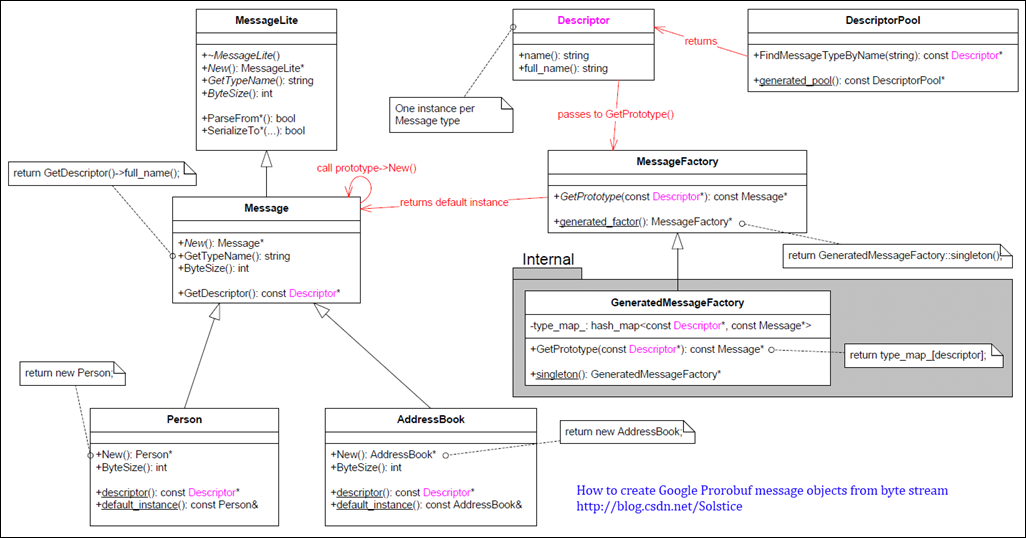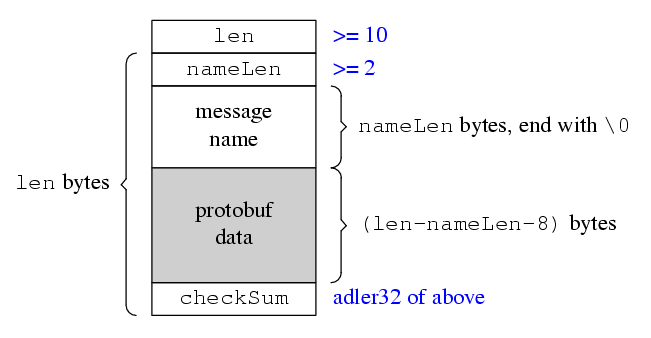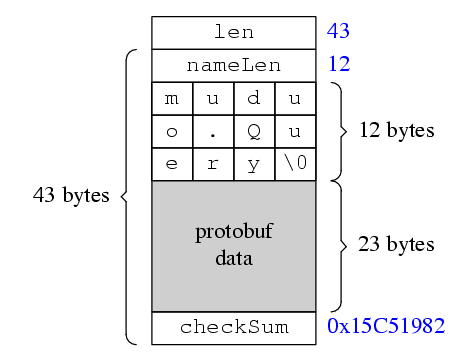陈硕 (giantchen_AT_gmail)
Blog.csdn.net/Solstice t.sina.com.cn/giantchen
这篇文章要解决的问题是:在接收到 protobuf 数据之后,如何自动创建具体的 Protobuf Message 对象,再做的反序列化。“自动”的意思是:当程序中新增一个 protobuf Message 类型时,这部分代码不需要修改,不需要自己去注册消息类型。其实,Google Protobuf 本身具有很强的反射(reflection)功能,可以根据 type name 创建具体类型的 Message 对象,我们直接利用即可。
本文假定读者了解 Google Protocol Buffers 是什么,这不是一篇 protobuf 入门教程。
本文以 C++ 语言举例,其他语言估计有类似的解法,欢迎补充。
本文的示例代码在: https://github.com/chenshuo/recipes/tree/master/protobuf
网络编程中使用 protobuf 的两个问题
Google Protocol Buffers (Protobuf) 是一款非常优秀的库,它定义了一种紧凑的可扩展二进制消息格式,特别适合网络数据传输。它为多种语言提供 binding,大大方便了分布式程序的开发,让系统不再局限于用某一种语言来编写。
在网络编程中使用 protobuf 需要解决两个问题:
- 长度,protobuf 打包的数据没有自带长度信息或终结符,需要由应用程序自己在发生和接收的时候做正确的切分;
- 类型,protobuf 打包的数据没有自带类型信息,需要由发送方把类型信息传给给接收方,接收方创建具体的 Protobuf Message 对象,再做的反序列化。
第一个很好解决,通常的做法是在每个消息前面加个固定长度的 length header,例如我在 《Muduo 网络编程示例之二: Boost.Asio 的聊天服务器》 中实现的 LengthHeaderCodec,代码见 http://code.google.com/p/muduo/source/browse/trunk/examples/asio/chat/codec.h
第二个问题其实也很好解决,Protobuf 对此有内建的支持。但是奇怪的是,从网上简单搜索的情况看,我发现了很多山寨的做法。
山寨做法
以下均为在 protobuf data 之前加上 header,header 中包含 int length 和类型信息。类型信息的山寨做法主要有两种:
- 在 header 中放 int typeId,接收方用 switch-case 来选择对应的消息类型和处理函数;
- 在 header 中放 string typeName,接收方用 look-up table 来选择对应的消息类型和处理函数。
这两种做法都有问题。
第一种做法要求保持 typeId 的唯一性,它和 protobuf message type 一一对应。如果 protobuf message 的使用范围不广,比如接收方和发送方都是自己维护的程序,那么 typeId 的唯一性不难保证,用版本管理工具即可。如果 protobuf message 的使用范围很大,比如全公司都在用,而且不同部门开发的分布式程序可能相互通信,那么就需要一个公司内部的全局机构来分配 typeId,每次增加新 message type 都要去注册一下,比较麻烦。
第二种做法稍好一点。typeName 的唯一性比较好办,因为可以加上 package name(也就是用 message 的 fully qualified type name),各个部门事先分好 namespace,不会冲突与重复。但是每次新增消息类型的时候都要去手工修改 look-up table 的初始化代码,比较麻烦。
其实,不需要自己重新发明轮子,protobuf 本身已经自带了解决方案。
根据 type name 反射自动创建 Message 对象
Google Protobuf 本身具有很强的反射(reflection)功能,可以根据 type name 创建具体类型的 Message 对象。但是奇怪的是,其官方教程里没有明确提及这个用法,我估计还有很多人不知道这个用法,所以觉得值得写这篇 blog 谈一谈。
以下是陈硕绘制的 Protobuf class diagram,点击查看原图。

我估计大家通常关心和使用的是图的左半部分:MessageLite、Message、Generated Message Types (Person, AddressBook) 等,而较少注意到图的右半部分:Descriptor, DescriptorPool, MessageFactory。
上图中,其关键作用的是 Descriptor class,每个具体 Message Type 对应一个 Descriptor 对象。尽管我们没有直接调用它的函数,但是Descriptor在“根据 type name 创建具体类型的 Message 对象”中扮演了重要的角色,起了桥梁作用。上图的红色箭头描述了根据 type name 创建具体 Message 对象的过程,后文会详细介绍。
原理简述
Protobuf Message class 采用了 prototype pattern,Message class 定义了 New() 虚函数,用以返回本对象的一份新实例,类型与本对象的真实类型相同。也就是说,拿到 Message* 指针,不用知道它的具体类型,就能创建和它类型一样的具体 Message Type 的对象。
每个具体 Message Type 都有一个 default instance,可以通过 ConcreteMessage::default_instance() 获得,也可以通过 MessageFactory::GetPrototype(const Descriptor*) 来获得。所以,现在问题转变为 1. 如何拿到 MessageFactory;2. 如何拿到 Descriptor*。
当然,ConcreteMessage::descriptor() 返回了我们想要的 Descriptor*,但是,在不知道 ConcreteMessage 的时候,如何调用它的静态成员函数呢?这似乎是个鸡与蛋的问题。
我们的英雄是 DescriptorPool,它可以根据 type name 查到 Descriptor*,只要找到合适的 DescriptorPool,再调用 DescriptorPool::FindMessageTypeByName(const string& type_name) 即可。眼前一亮?
在最终解决问题之前,先简单测试一下,看看我上面说的对不对。
简单测试
本文用于举例的 proto 文件:query.proto,见 https://github.com/chenshuo/recipes/blob/master/protobuf/query.proto
package muduo;
message Query {
required int64 id = 1;
required string questioner = 2;
repeated string question = 3;
}
message Answer {
required int64 id = 1;
required string questioner = 2;
required string answerer = 3;
repeated string solution = 4;
}
message Empty {
optional int32 id = 1;
}
其中的 Query.questioner 和 Answer.answerer 是我在前一篇文章这提到的《分布式系统中的进程标识》。
以下代码验证 ConcreteMessage::default_instance()、ConcreteMessage::descriptor()、 MessageFactory::GetPrototype()、DescriptorPool::FindMessageTypeByName() 之间的不变式 (invariant):
https://github.com/chenshuo/recipes/blob/master/protobuf/descriptor_test.cc#L15
typedef muduo::Query T;
std::string type_name = T::descriptor()->full_name();
cout << type_name << endl;
const Descriptor* descriptor = DescriptorPool::generated_pool()->FindMessageTypeByName(type_name);
assert(descriptor == T::descriptor());
cout << "FindMessageTypeByName() = " << descriptor << endl;
cout << "T::descriptor() = " << T::descriptor() << endl;
cout << endl;
const Message* prototype = MessageFactory::generated_factory()->GetPrototype(descriptor);
assert(prototype == &T::default_instance());
cout << "GetPrototype() = " << prototype << endl;
cout << "T::default_instance() = " << &T::default_instance() << endl;
cout << endl;
T* new_obj = dynamic_cast<T*>(prototype->New());
assert(new_obj != NULL);
assert(new_obj != prototype);
assert(typeid(*new_obj) == typeid(T::default_instance()));
cout << "prototype->New() = " << new_obj << endl;
cout << endl;
delete new_obj;
根据 type name 自动创建 Message 的关键代码
好了,万事具备,开始行动:
- 用 DescriptorPool::generated_pool() 找到一个 DescriptorPool 对象,它包含了程序编译的时候所链接的全部 protobuf Message types。
- 用 DescriptorPool::FindMessageTypeByName() 根据 type name 查找 Descriptor。
- 再用 MessageFactory::generated_factory() 找到 MessageFactory 对象,它能创建程序编译的时候所链接的全部 protobuf Message types。
- 然后,用 MessageFactory::GetPrototype() 找到具体 Message Type 的 default instance。
- 最后,用 prototype->New() 创建对象。
示例代码见 https://github.com/chenshuo/recipes/blob/master/protobuf/codec.h#L69
Message* createMessage(const std::string& typeName)
{
Message* message = NULL;
const Descriptor* descriptor = DescriptorPool::generated_pool()->FindMessageTypeByName(typeName);
if (descriptor)
{
const Message* prototype = MessageFactory::generated_factory()->GetPrototype(descriptor);
if (prototype)
{
message = prototype->New();
}
}
return message;
}
调用方式:https://github.com/chenshuo/recipes/blob/master/protobuf/descriptor_test.cc#L49
Message* newQuery = createMessage("muduo.Query");
assert(newQuery != NULL);
assert(typeid(*newQuery) == typeid(muduo::Query::default_instance()));
cout << "createMessage(\"muduo.Query\") = " << newQuery << endl;
古之人不余欺也 :-)
注意,createMessage() 返回的是动态创建的对象的指针,调用方有责任释放它,不然就会内存泄露。在 muduo 里,我用 shared_ptr<Message> 来自动管理 Message 对象的生命期。
线程安全性
Google 的文档说,我们用到的那几个 MessageFactory 和 DescriptorPool 都是线程安全的,Message::New() 也是线程安全的。并且它们都是 const member function。
关键问题解决了,那么剩下工作就是设计一种包含长度和消息类型的 protobuf 传输格式。
Protobuf 传输格式
陈硕设计了一个简单的格式,包含 protobuf data 和它对应的长度与类型信息,消息的末尾还有一个 check sum。格式如下图,图中方块的宽度是 32-bit。

用 C struct 伪代码描述:
struct ProtobufTransportFormat __attribute__ ((__packed__))
{
int32_t len;
int32_t nameLen;
char typeName[nameLen];
char protobufData[len-nameLen-8];
int32_t checkSum; // adler32 of nameLen, typeName and protobufData
};
注意,这个格式不要求 32-bit 对齐,我们的 decoder 会自动处理非对齐的消息。
例子
用这个格式打包一个 muduo.Query 对象的结果是:

设计决策
以下是我在设计这个传输格式时的考虑:
- signed int。消息中的长度字段只使用了 signed 32-bit int,而没有使用 unsigned int,这是为了移植性,因为 Java 语言没有 unsigned 类型。另外 Protobuf 一般用于打包小于 1M 的数据,unsigned int 也没用。
- check sum。虽然 TCP 是可靠传输协议,虽然 Ethernet 有 CRC-32 校验,但是网络传输必须要考虑数据损坏的情况,对于关键的网络应用,check sum 是必不可少的。对于 protobuf 这种紧凑的二进制格式而言,肉眼看不出数据有没有问题,需要用 check sum。
- adler32 算法。我没有选用常见的 CRC-32,而是选用 adler32,因为它计算量小、速度比较快,强度和 CRC-32差不多。另外,zlib 和 java.unit.zip 都直接支持这个算法,不用我们自己实现。
- type name 以 '\0' 结束。这是为了方便 troubleshooting,比如通过 tcpdump 抓下来的包可以用肉眼很容易看出 type name,而不用根据 nameLen 去一个个数字节。同时,为了方便接收方处理,加入了 nameLen,节省 strlen(),空间换时间。
- 没有版本号。Protobuf Message 的一个突出优点是用 optional fields 来避免协议的版本号(凡是在 protobuf Message 里放版本号的人都没有理解 protobuf 的设计),让通信双方的程序能各自升级,便于系统演化。如果我设计的这个传输格式又把版本号加进去,那就画蛇添足了。具体请见本人《分布式系统的工程化开发方法》第 57 页:消息格式的选择。
示例代码
为了简单起见,采用 std::string 来作为打包的产物,仅为示例。
打包 encode 的代码:https://github.com/chenshuo/recipes/blob/master/protobuf/codec.h#L35
解包 decode 的代码:https://github.com/chenshuo/recipes/blob/master/protobuf/codec.h#L99
测试代码: https://github.com/chenshuo/recipes/blob/master/protobuf/codec_test.cc
如果以上代码编译通过,但是在运行时出现“cannot open shared object file”错误,一般可以用 sudo ldconfig 解决,前提是 libprotobuf.so 位于 /usr/local/lib,且 /etc/ld.so.conf 列出了这个目录。
$ make all # 如果你安装了 boost,可以 make whole
$ ./codec_test
./codec_test: error while loading shared libraries: libprotobuf.so.6: cannot open shared object file: No such file or directory
$ sudo ldconfig
与 muduo 集成
muduo 网络库将会集成对本文所述传输格式的支持(预计 0.1.9 版本),我会另外写一篇短文介绍 Protobuf Message <=> muduo::net::Buffer 的相互转化,使用 muduo::net::Buffer 来打包比上面 std::string 的代码还简单,它是专门为 non-blocking 网络库设计的 buffer class。
此外,我们可以写一个 codec 来自动完成转换,就行 asio/char/codec.h 那样。这样客户代码直接收到的就是 Message 对象,发送的时候也直接发送 Message 对象,而不需要和 Buffer 对象打交道。
消息的分发 (dispatching)
目前我们已经解决了消息的自动创建,在网络编程中,还有一个常见任务是把不同类型的 Message 分发给不同的处理函数,这同样可以借助 Descriptor 来完成。我在 muduo 里实现了 ProtobufDispatcherLite 和 ProtobufDispatcher 两个分发器,用户可以自己注册针对不同消息类型的处理函数。预计将会在 0.1.9 版本发布,您可以先睹为快:
初级版,用户需要自己做 down casting: https://github.com/chenshuo/recipes/blob/master/protobuf/dispatcher_lite.cc
高级版,使用模板技巧,节省用户打字: https://github.com/chenshuo/recipes/blob/master/protobuf/dispatcher.cc
基于 muduo 的 Protobuf RPC?
Google Protobuf 还支持 RPC,可惜它只提供了一个框架,没有开源网络相关的代码,muduo 正好可以填补这一空白。我目前还没有决定是不是让 muduo 也支持以 protobuf message 为消息格式的 RPC,muduo 还有很多事情要做,我也有很多博客文章打算写,RPC 这件事情以后再说吧。
注:Remote Procedure Call (RPC) 有广义和狭义两种意思。狭义的讲,一般特指 ONC RPC,就是用来实现 NFS 的那个东西;广义的讲,“以函数调用之名,行网络通信之实”都可以叫 RPC,比如 Java RMI,.Net Remoting,Apache Thrift,libevent RPC,XML-RPC 等等。
(待续)